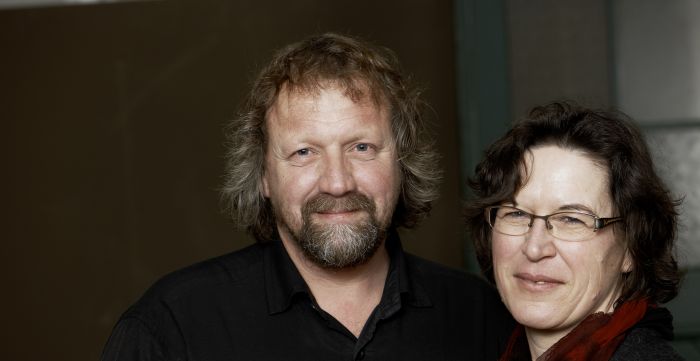
producer profile
31.05.2019
Clemens Busch Producer Profile
<p>Since taking over his family winery in 1984, Clemens Busch and his wife Rita have shaped it into one of the most iconoclastic <glossary title="427">estates</glossary> in the <span class="zalup"><span><glossary title="689">Mosel</glossary><span>.</span></span></span> A firm believer that natural<glossary title=""> </glossary>practices in the vines and <glossary title="254">cellar </glossary>lead to to the ultimate expression of <span class="zalup"><span><glossary title="1026">terroir</glossary><span>,</span></span></span> Clemens exemplifies the balance between tradition and forward thinking we so look forward to when seeking out new producers.</p>
<p>The majority of Clemens' production is grown on the extremely steep <glossary title="1148">Pündericher </glossary><glossary title="">Marienburg</glossary>, a 25 <glossary title="523">hectare </glossary>hill that spans an entire hillside facing the village of <glossary title="1147">Pünderich.</glossary> <glossary title="430">Exposed </glossary>full south/southeast and right on the edge of the river, it is widely considered amongst the very best sites in the <span class="zalup"><span><glossary title="689">Mosel</glossary><span>.</span></span></span> 17 <glossary title="523">hectares</glossary> of the hill are planted in vines and Clemens owns 11 of them.<br />
<br />
As more and more of his neighbors abandoned the great vineyards of the <glossary title="1148">Marienburg </glossary>throughout the 1980's to plant <glossary title="805">Pinot Noir </glossary>in the plains (which could be worked <glossary title="645">mechanically</glossary> and was in much higher demand at the time), Clemens capitalized on their eagerness to sell at low prices. Starting with just two <span class="zalup"><span><glossary title="523">hectares</glossary><span>,</span></span></span> in due time he managed to acquire <glossary title="672">monopoles </glossary>of many of the <glossary title="1148">Marienburg's</glossary> different<strong> </strong>sites, sometimes going as far as buying neighboring <glossary title="760">parcels </glossary>from 11 different owners! <br />
<br />
The <glossary title="594">lieu-dit</glossary><glossary title="594"></glossary> <glossary title="1148">Marienburg </glossary>was originally a much smaller, individual <glossary title="760">parcel </glossary>that shared the hill with many other vineyards, all with their own names and attributes. In 1971, a law hoping to unify the identity of the area's varied <glossary title="1026">terroirs </glossary>declared that the entire hill be re-named <span class="zalup"><span><glossary title="1148">Marienburg</glossary><span>.</span></span></span> This decision never sat well with Clemens; as the fifth generation working this land, he knew that these vineyards featured different soil compositions and <glossary title="656">micro-climactic</glossary> variables influenced by fissures, vineyard walls, the inclination of slope and <span class="zalup"><span><glossary title="430">exposure</glossary><span>.</span></span></span> In such, Clemens <glossary title="">vinifies</glossary> his wines site by site and <glossary title="185">bottles</glossary> them by the historic vineyard names. <br />
<br />
The original<strong> <glossary title="1148">Marienberg</glossary></strong> vineyard faces south/southeast, is dominated by <glossary title="961">grey slate</glossary><glossary title="961"></glossary> and also produces "Vom Grauen Schiefer" (from <glossary title="961">grey slate</glossary><glossary title="961"></glossary>) and "Vom Roten Schiefer" (from <glossary title="961">red </glossary><glossary title="961">slate</glossary>) as well as the <span class="zalup"><span><glossary title="1149">Marienburg GG</glossary><span>.</span></span></span> <br />
<br />
Rothenpfad is all <glossary title="961">red </glossary><glossary title="961">slate</glossary>, a true rarity in the <span class="zalup"><span><glossary title="689">Mosel</glossary><span>.</span></span></span> Prior to 2006, most of this hard to reach area was overgrown. A land consolidation permitted Clemens to replant and save some <span class="zalup"><span><glossary title="740">old vines</glossary><span>.</span></span></span> Today, about a <glossary title="523">hectare </glossary>is grown.<br />
<br />
Farhlay is the only part of the hill dominated by <glossary title="961">blue slate</glossary><glossary title="961"></glossary>. The soil is particularly rocky, so the vines must dig deep to find their nutrition here, resulting in a <glossary title="662">mineral </glossary>style. <br />
<br />
Falkenlay is defined by <glossary title="961">grey slate</glossary><glossary title="961"></glossary>, and located between Rothpfad and Farhlay. Considered by some to be the finest site on the <span class="zalup"><span><glossary title="1148">Marienburg</glossary><span>,</span></span></span> it provides the best grapes for <span class="zalup"><span><glossary title="181">noble sweet wines</glossary><span>.</span></span></span> A special selection of the best grapes from the <glossary title="740">old vines</glossary> of this vineyard are bottled under the name "Raffes". <br />
<br />
Finally, Felsterrasse is a tiny <glossary title="1022">terraced</glossary> <glossary title="760">parcel</glossary> and Clemens' favorite. The soils are composed of thick <glossary title="961">grey slate</glossary> and are particularly hard to work. <br />
<br />
80% of the wines are <glossary title="441">fermented</glossary> and <glossary title="74">aged</glossary> in very old, 1000 liter <glossary title="142">barrels</glossary>; the youngest are 48 years old and many were built by Rita's father. Nothing is ever added to the wine, save a low dose of <glossary title="993">sulfur</glossary><glossary title="993"> </glossary>at <span class="zalup"><span><glossary title="185">bottling</glossary><span>.</span></span></span> The wines are never <span class="zalup"><span><glossary title="449">fined</glossary><span>.</span></span></span> For the sweet and <span class="zalup"><span><glossary title="181">noble sweet wines</glossary><span>,</span></span></span> Clemens prefers halting the <glossary title="441">fermentation </glossary>with a deep freeze followed by a <span class="zalup"><span><glossary title="447">filtration</glossary><span>,</span></span></span> allowing him to drastically reduce <span class="zalup"><span><glossary title="993">sulfur</glossary><span>,</span></span></span> which again is only added at <span class="zalup"><span><glossary title="185">bottling</glossary><span>.</span></span></span><br />
<br />
Pay attention to the <glossary title="1177">capsules </glossary>on the top of each different <span class="zalup"><span><glossary title="185">bottling</glossary><span>,</span></span></span> as their color (red, grey, blue) indicate the <glossary title="961">slate</glossary> type of each vineyard. </p>
Article
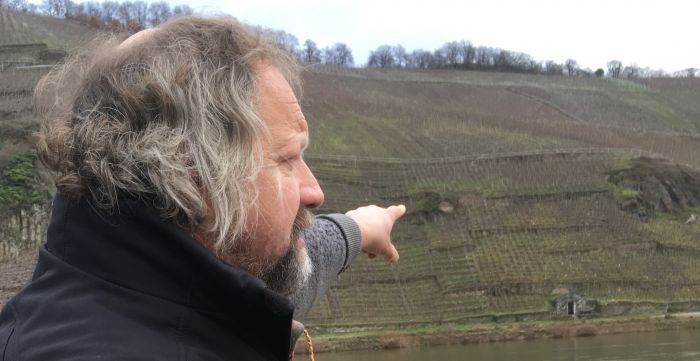
interview
22.05.2019
An Interview with Clemens Busch from 2014
<p><em>This interview with Clemens Busch took place in February, 2014 at </em><glossary title="568"><em>L'Herbe Rouge</em></glossary><em>.</em></p>
<p><strong>Can you give us a global introduction of the estate?</strong><br />
<br />
We are located in the middle <glossary title="689">Mosel </glossary>region of Germany. All our vines are planted on extremely steep <span class="zalup"><span><glossary title="1022">terraces</glossary><span>,</span></span></span> most of them located on the <glossary title="1148">Marienburg</glossary> vineyard. It's a very special place, with three distinct soil types: <span class="zalup"><span><glossary title="961">red, grey and blue slate</glossary><span>.</span></span></span> We work predominantly with <glossary title="740">old vines</glossary>; most are 40, 50 or older. Their <glossary title="869">roots</glossary> go very deep into the <span class="zalup"><span><glossary title="690">mother rock</glossary><span>,</span></span></span> which is essential for expressing our <span class="zalup"><span><glossary title="1026">terroirs</glossary><span>.</span></span></span><br />
<br />
<strong>Your family has a long tradition of winemaking in the village of Pünderich. Can you tell us about the Busch's history?</strong><br />
<br />
The Busch family has indeed been making wine in <glossary title="1147">Pünderich </glossary>for a very long time. In our area, there weren't really any other opportunities outside of <span class="zalup"><span><glossary title="78">agriculture</glossary><span>.</span></span></span> Most families made wine from the <span class="zalup"><span><glossary title="1148">Marienburg</glossary><span>,</span></span></span> worked fields (potatoes and vegetables) and raised livestock and horses. It was a much more self-contained and self-sustained context than the world we live in today. Since most families worked in <span class="zalup"><span><glossary title="815">polyculture</glossary><span>,</span></span></span> there was no real economic pressure since we could provide food for ourselves. <br />
<br />
My grandfather was the first to focus exclusively on wine. He developed a good reputation and had a lot of customers all over Germany. This permitted him to expand by purchasing more vineyards from other growers, and he also had a side business buying and reselling<strong> <glossary title="1072">VDP</glossary></strong> wine in auctions. He started in the early 1920's and became quite successful. <br />
<br />
After the second World War, everything collapsed and he had to start from scratch. My father had gotten involved at this point and the two re-focused solely on their own production. <br />
<br />
<strong>How did you personally get involved?</strong> <br />
<br />
I started in 1974, when I was 17 years old. At the time, it was normal to learn everything from father to son in the winery; going to school for <glossary title="1103">viticulture </glossary>and <glossary title="422">oenology </glossary>was unheard of. The first <glossary title="1109">vintage </glossary>I helped produce was 1975, which was a great <span class="zalup"><span><glossary title="1109">vintage</glossary><span>,</span></span></span> not only in quality but because it was a very easy year to work in the vineyards. <br />
<br />
<strong>When you started, what was your philosophy towards viticulture and winemaking? </strong><br />
<br />
After WW2, the main focus for many of that generation was to make money. It was a very tough economic time. But over the years, I began to form my own ideas and work philosophy. <br />
<br />
By 1976 I had already stopped using <span class="zalup"><span><glossary title="526">herbicides</glossary><span>,</span></span></span> and this was the first step towards <glossary title="746">organic </glossary>production. It was a simple observation on my part: <em>"Why can't we live with the herbs?"</em> It just felt completely normal to respect this, and after three or four years, I started to notice more and more <glossary title="531">humus </glossary>in the vineyards, which encouraged me to not use <span class="zalup"><span><glossary title="442">fertilizers</glossary><span>.</span></span></span> <br />
<br />
In the early 80's, I met some local growers from the middle <glossary title="689">Mosel </glossary>who were also interested in <glossary title="746">organic</glossary> <span class="zalup"><span><glossary title="1103">viticulture</glossary><span>,</span></span></span> and this is when my philosophy became more clearly defined. Once we started using plant based concoctions such as <span class="zalup"><span><glossary title="1207">fungicides</glossary><span>,</span></span></span> this pushed us in a new direction. <br />
<br />
<strong>What about in the cellar? </strong><br />
<br />
We work with <span class="zalup"><span><glossary title="739">old oak</glossary><span>.</span></span></span> My father worked with <span class="zalup"><span><glossary title="976">spontaneous fermentations</glossary><span>,</span></span></span> so that was always totally normal to me. I've never had a problem with <span class="zalup"><span><glossary title="441">fermentations</glossary><span>.</span></span></span> <br />
<br />
<strong>What about sulfur use?</strong><br />
<br />
I've been experimenting with <glossary title="993">sulfur </glossary>since the 80's. Back then, I knew of only one producer who made <glossary title="913">sulfur </glossary>free wine, but they weren't very good. The wine had no <span class="zalup"><span><glossary title="993">sulfur</glossary><span>,</span></span></span> but it was made with <span class="zalup"><span><glossary title="540">industrial techniques</glossary><span>,</span></span></span> and only ended up being commercialized for about two years. <br />
<br />
Still, it served as a motivation for myself and a few other <glossary title="746">organic </glossary>producers to experiment. I've been trying for 30 years and I still haven't figured out a way to make a wine without <glossary title="993">sulfur </glossary>that I am satisfied with. As you know, we recently bottled a small amount of <glossary title="993">sulfur </glossary>free <span class="zalup"><span><glossary title="1049">Riesling Trocken</glossary><span>.</span></span></span> Some people really like it, but for me it's more about the experiment, to further understand what it tastes like. And this is a strange wine: <glossary title="441">fermentation </glossary>took seven months, it spent two years on the <glossary title="590">lees </glossary>and had a long <glossary title="610">maceration </glossary>of 48 hours. But it still doesn't work, at least not for me. <br />
<br />
I've tasted many <glossary title="993">sulfur </glossary>free wines from Italy and France that work. In their cases though, I do feel that their situation is better suited for this choice than mine. <br />
<br />
<strong>Why do you think that is?</strong><br />
<br />
I think it's the <glossary title="858">Riesling </glossary>grape and our <span class="zalup"><span><glossary title="1026">terroirs</glossary><span>.</span></span></span> But this will not stop me from continuing my experimentations! For now, I'm happy with promoting low <glossary title="993">sulfur</glossary> <span class="zalup"><span><glossary title="858">Rieslings</glossary><span>.</span></span></span> <br />
<br />
<strong>Can we talk about the Marienburg? It's quite a place. </strong><br />
<br />
The <glossary title="1148">Marienburg </glossary>is a wonderful vineyard. It's <glossary title="430">exposed </glossary>full south, it's very steep and there are multiple <glossary title="1022">terraces </glossary>with totally different <glossary title="656">micro-climates</glossary> and soil compositions. This makes for a very diverse experience both in the vines and with the wines. It's also right in front of our house! I open my kitchen window and there it is! It's very inspiring drinking a bottle of wine in the evening with the lay of the land right there in front of you. It's almost like we live directly in the vines. <br />
<br />
It's also worth mentioning that 80% of it is planted in <span class="zalup"><span><glossary title="740">old vines</glossary><span>.</span></span></span> <br />
<br />
As far as the vineyard's history, the multiple <glossary title="1022">terraces</glossary> within today's <glossary title="1148">Marienburg </glossary>all have historic names, and in fact <glossary title="1148">Marienburg </glossary>used to be the name of a specific part of the hill, not the entire thing. <br />
<br />
It was decided in the early 70's that these multiple <glossary title="1178">designations </glossary>were too complicated for the international market, and that a larger, unified vineyard site would be simpler to remember. But for us, the different soils and <glossary title="656">microclimates </glossary>of the <glossary title="1148">Marienburg </glossary>are what make this land so interesting in the first place. We therefore chose to <glossary title="185">bottle</glossary> and name our wines based on the <glossary title="760">parcels</glossary>' original names (Farhlay, Falkenlay, etc...) <br />
<br />
<strong>This law also permitted wine from nearby plains to carry the Marienburg designation, correct? </strong><br />
<br />
The <glossary title="1148">Marienburg </glossary><glossary title="1178">designation</glossary> covers 80 <glossary title="523">hectares </glossary>of vines, and only 25 of those are on the hills. We own 16 of these 25 <span class="zalup"><span><glossary title="">hectares</glossary><span>,</span></span></span> and as far as I am concerned, the vines directly across from my house are the only ones I would actually call <span class="zalup"><span><glossary title="1148">Marienburg</glossary><span>.</span></span></span> <br />
<br />
<strong>So you own over half of the Marienburg? </strong><br />
<br />
I started with two <glossary title="523">hectares </glossary>on the <glossary title="1148">Marienburg </glossary>spread over 16 <span class="zalup"><span> <glossary title="760">parcels</glossary><span>!</span></span></span> At the time, it was impossible to work <span class="zalup"><span><glossary title="746">organically</glossary><span>,</span></span></span> because each <glossary title="760">parcel </glossary>was too small and isolated. The biggest was 725 meters wide and the smallest 123! So we started buying neighboring bits as opportunities arose, but everything really started changing in the 80's. <br />
<br />
Many growers of my father's generation retired without an heir, as their sons were not interested in the hard work involved in maintaining the <span class="zalup"><span><glossary title="1022">terraces</glossary><span>.</span></span></span> Those that did continue making wine began following the trend and high demand for German Pinots<glossary title=""> </glossary>(<span class="zalup"><span><glossary title="801">blanc</glossary><span>,</span></span></span> <span class="zalup"><span> <glossary title="803">gris</glossary><span>,</span></span></span> and mostly <glossary title="805">noir</glossary>) and other red grapes, which are more suited to be grown on plains. And also much easier to work! <br />
<br />
As the hill progressively got more abandoned, I saw this as an opportunity to get the best vineyards in the best sections. I wanted to focus on my region's traditional grape (<glossary title="858">Riesling </glossary>represents 99% of our production), but also the luxury of having 1.5 <glossary title="523">hectares </glossary>or more of vines in the same place is a great privilege in the <span class="zalup"><span><glossary title="689">Mosel</glossary><span>.</span></span></span> <br />
<br />
<strong>When did you decide to have each bottling's foil be the color of the slate soils the grapes were grown on (red, grey, blue)?</strong><br />
<br />
We changed the labels in 2006, and we started using the color indicators at that time. It was a marketing friend of mine's idea, and it totally made sense to me. This makes it exceedingly easy for <glossary title="969">sommeliers</glossary> and the consumer to easily identify the <span class="zalup"><span><glossary title="1026">terroir</glossary><span>.</span></span></span> <br />
<br />
<strong>What do you like to drink?</strong><br />
<br />
I'm a big fan of <span class="zalup"><span><glossary title="212">Burgundy</glossary><span>.</span></span></span> Another recent favorite is <span class="zalup"><span><glossary title="697">Muscadet</glossary><span>.</span></span></span> As long as it's interesting, I want to try it. The last ten years have have seen an explosion in the amount of <glossary title="427">estates </glossary>working with philosophies I align myself with, and it's been very fun discovering all of these!</p>
Article
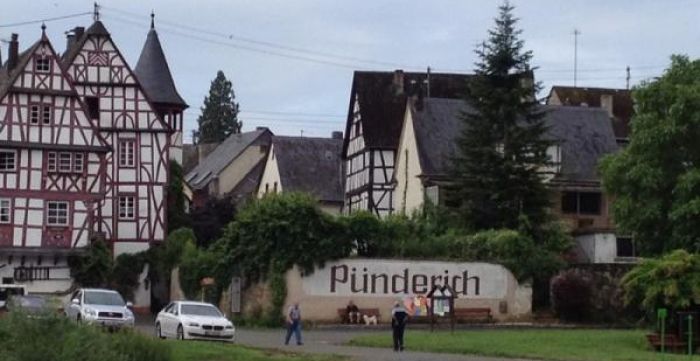
producer visit
17.07.2019
This visit with Clemens Busch took place in February, 2013
<p><strong><em>This visit with Clemens Busch took place in February, 2013.</em></strong></p>
<p><strong><em>Words by Jules Dressner, photos by Jake Halper and Jules Dressner.</em></strong></p>
<p>The Busch family's house is right on the edge of the <span class="zalup"><span><glossary title="689">Mosel</glossary><span>,</span></span></span> in the village of <span class="zalup"><span><glossary title="1147">Pünderich</glossary><span>.</span></span></span> As we pulled up to their house, a bunch of swans were gathering. </p>
<p><img src="http://louisdressner.com/uploads/images/article/2019_Jul_17//e6/a6/e6a6af92a3404264fcdc2c4312d97557.jpg" /></p>
<p>Apparently, this happens all the time. <br />
<br />
The famed <glossary title="1148">Marienburg </glossary>vineyard is directly across the river from Clemens and Rita's house. </p>
<p><img src="http://louisdressner.com/uploads/images/article/2019_Jul_17//3f/22/3f225f18d637b5e9be6c015af0d9c99d.jpg" /></p>
<p><img src="http://louisdressner.com/uploads/images/article/2019_Jul_17//4d/a3/4da315a25a83ae77ac90ece9399144c1.jpg" /><br />
<br />
11 of the Busch's 16 <glossary title="523">hectares </glossary>are here. Before setting out to the vines, Clemens proposed we take advantage of the view for him to explain why he <glossary title="1104">vinifies </glossary>wines according to the many specific sites on the hill. <br />
<br />
Prior to new laws in the 1970's, this area was comprised of many small individual vineyard sites, including one originally called <span class="zalup"><span><glossary title="1148">Marienburg</glossary><span>.</span></span></span> Hoping to capitalize on this particular site's reputation, it was decided that the entire 17<glossary title="523"> hectares </glossary>on the hill be renamed <span class="zalup"><span><glossary title="1148">Marienburg</glossary><span>,</span></span></span> as well as an expansion of north facing plains across the river. Clemens owns 11 of the 17 <glossary title="523">hectares </glossary>that form the hillside, and as the fifth generation to work this land, was well aware that the individual sites produced very different wines. In such, he <glossary title="1104">vinifies </glossary>them separately. The wines are all labelled as <strong><glossary title="1148">Marienburg</glossary></strong>, and the <glossary title="363">cuvée </glossary>names are the historic names of the old sites: Fahrlay, Falkenlay, Rothenpfad and Felsterrasse.<br />
<br />
Normally, one would take an extremely short ferry ride over to the vines. But since the <glossary title="689">Mosel </glossary>was so high that day, we instead had to take a 6km detour to get to the top of the hill.<br />
<img src="http://louisdressner.com/uploads/images/article/2019_Jul_17//ac/42/ac4207048384a8c1a16a8bfcbd873183.jpg" /></p>
<p><img src="http://louisdressner.com/uploads/images/article/2019_Jul_17//69/9b/699b6d18a9984a2b17894cc2876089af.jpg" /><br />
<br />
Just 40 years ago, <glossary title="1148">Marienburg </glossary>was full of vineyards, but today a lot of it is abandoned. For example, Clemens is planning to purchase this <glossary title="760">parcel</glossary> on <glossary title="961">red slate </glossary>to replant. </p>
<p><img src="http://louisdressner.com/uploads/images/article/2019_Jul_17//bf/84/bf84ead652c8788c60229c8c4a1ac511.jpg" /><br />
<br />
To do this, he would need to use a machine similar to a Catepillar. <br />
<br />
After getting the bird's eye view, we drove down to the bottom of the hill, where we got our feet wet in the <glossary title="689">Mosel's</glossary> high tide.</p>
<p><img src="http://louisdressner.com/uploads/images/article/2019_Jul_17//94/39/9439bd1a2cf1b14a3b5e79fb5924db68.jpg" /></p>
<p><img src="http://louisdressner.com/uploads/images/article/2019_Jul_17//89/4c/894c59dd54a1a05f8903e113efffea60.jpg" /></p>
<p>We started by visiting Farhlay. </p>
<p><img src="http://louisdressner.com/uploads/images/article/2019_Jul_17//29/59/2959d586748dd1dca8ad51b769b8a21d.jpg" /></p>
<p><img src="http://louisdressner.com/uploads/images/article/2019_Jul_17//c3/47/c347b3f9a4aab65c0016ec77fdabba6b.jpg" /></p>
<p>This site represents 1.4 <glossary title="523">hectares </glossary>total. Clemens has a <glossary title="672">monopole </glossary>on it, which he acquired by buying bits and pieces from 11 different owners! The vines are 75 years old and <glossary title="430">exposed</glossary> full south. The soil doesn't need to be worked too hard here, because the summers are very hot and burn a lot of the herbs. Clemens has always worked <span class="zalup"><span><glossary title="746">organically</glossary><span>,</span></span></span> but got his <glossary title="260">certification </glossary>in 1986. In the winter, five people work the vines, mostly family. In Spring and Summer, it gets to 10 at its biggest. <br />
<br />
Either by the force of nature or a previous passerby, I noticed a perfect example of the <glossary title="1148">Marienburg's </glossary><glossary title="961">red, grey and blue slate </glossary>right in front of my eyes!</p>
<p><img src="http://louisdressner.com/uploads/images/article/2019_Jul_17//35/a9/35a918e11cd45af7003620b5c923ef8d.jpg" /><br />
<br />
One Slate, Two Slate, Red Slate, Blue slate! <br />
<br />
Clemens hadn't <glossary title="834">pruned </glossary>yet, but for the neighbors who did, it was looking like a pre-Valentine's day celebration.</p>
<p><img src="http://louisdressner.com/uploads/images/article/2019_Jul_17//94/18/9418a6b5031c6c3038ba23ddd57169e0.jpg" /><br />
<br />
We then visited Falkenlay.</p>
<p><img src="http://louisdressner.com/uploads/images/article/2019_Jul_17//09/59/0959061406e7c8f750a4c8a44f7390c8.jpg" /></p>
<p><img src="http://louisdressner.com/uploads/images/article/2019_Jul_17//ec/25/ec259cc3f56cdd05e90a0a42c29ead64.jpg" /></p>
<p><img src="http://louisdressner.com/uploads/images/article/2019_Jul_17//79/79/79798d69f26f8978a323cc833ba9e204.jpg" /></p>
<p>When asked about the expansion of <glossary title="1148">Marienburg </glossary>into the plains, Clemens had this to say:<br />
<br />
<em>"People started making wine here 2000 years ago. Vines have only been in the plains for 50 years. We need to respect tradition and continue this good work. "</em><br />
<br />
Case in point: Clemens owns 11 of the 17 <font color="#7b143e"><b><glossary term="Hectare" title="523">hectares</glossary> planted on the</b></font> <span class="zalup"><span><glossary title="1148">Marienburg</glossary><span>,</span></span></span> uncontestedly one of the best sites in the entire <span class="zalup"><span> <glossary title="689">Mosel</glossary><span>.</span></span></span> He was able to acquire most of this in the 1980's, because many growers started abandoning the <glossary title="1022">terraces </glossary>to cultivate red vines in the plains. There was a higher demand for <glossary title="805">Pinot </glossary>at the time, and it was a lot easier to work <span class="zalup"><span><glossary title="645">mechanically</glossary><span>.</span></span></span><br />
<br />
<em>"Now the same people are coming back and willing to pay a lot to reacquire some of these sites."</em><br />
<br />
The last site we visited was Clemens' favorite, Felsterrasse.</p>
<p><img src="http://louisdressner.com/uploads/images/article/2019_Jul_17//d4/a0/d4a06ff10c1fb3f5ac73f8bdd40b44ab.jpg" /><br />
<br />
Felterrasse is what you see above the first rows of vines. It is notoriously tough to access, and the very hard grey <glossary title="961">slate </glossary>is very challenging to work. A single <glossary title="185">bottling </glossary>is produced from this <span class="zalup"><span><glossary title="760">parcel</glossary><span>.</span></span></span> <br />
<br />
Look, I found a picture Josefa took of a lizard last summer!</p>
<p><img src="http://louisdressner.com/uploads/images/article/2019_Jul_17//4e/22/4e22a487627360fc4b9a04e8e056714d.jpg" /></p>
<p>They do live in the vineyards!<br />
<br />
After visiting the vines, it was <glossary title="254">cellar </glossary>time. There are two <glossary title="254">cellars </glossary>(one of which is very small) as well as a separate space for <glossary title="185">bottling</glossary>/ <span class="zalup"><span><glossary title="573">labeling</glossary><span>.</span></span></span> <br />
<br />
80% of the wines are produced in very old, 1000 liter <span class="zalup"><span><glossary title="142">barrels</glossary><span>.</span></span></span> </p>
<p><img src="http://louisdressner.com/uploads/images/article/2019_Jul_17//8e/58/8e588da7bd0f031dbefccff13f428e33.jpg" /><br />
<br />
The youngest are 48 years old and were produced by Rita's father. We tasted some 2012's, but they were so far from completion that it was hard to tell how the wines will end up. I'm guessing delicious. <br />
<br />
After visiting the <span class="zalup"><span><glossary title="254">cellar</glossary><span>,</span></span></span> Rita joined us and an epic, five hour tasting ensued. Thankfully, there was a dinner break in the middle. I learned so much, including what the ever recurring "<glossary title="1149">GG</glossary>" on many of the bottles meant.<br />
<br />
<glossary title="1149">GG </glossary>is a designation reserved only for members of the <span class="zalup"><span><glossary title="1072">VDP</glossary><span>,</span></span></span> a private group of 197 German winemakers. It stands for <glossary title="1149">Großes Gewächs</glossary> (<em>Great Growth</em>, which is nice since it also works in English), and the wine must be <span class="zalup"><span><glossary title="405">dry</glossary><span>.</span></span></span> A panel of <glossary title="1089">vignerons </glossary>come to inspect the site and approve the grapes. Then another panel with different members tastes the wines and deems it worthy. That's a serious process. <br />
<br />
One of the major highlights was tasting a 2005 "Farhlay <glossary title="127">Auslese</glossary>" that took 30 months to <span class="zalup"><span><glossary title="441">ferment</glossary><span>.</span></span></span> <br />
<br />
<em>"He bottled the </em><glossary title="405"><em>dry</em></glossary><em> 2007's at the same time!" </em><br />
<br />
-Rita<br />
<br />
Another was the 2007 <span class="zalup"><span><glossary title="1150">trockenbeerenauslese</glossary><span>,</span></span></span> which was the first time Clemens was tasting it since <span class="zalup"><span><glossary title="185">bottling</glossary><span>.</span></span></span> He seemed to like it. At 5,5% alcohol, it was barely felt like wine.</p>
Article
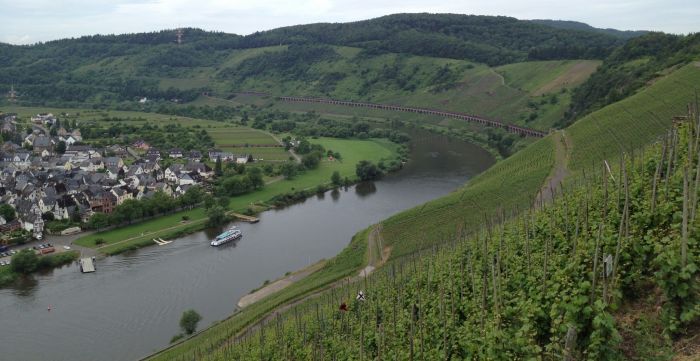
harvest report
06.01.2020
2020 Harvest Report from Rita Busch
<p><u><strong>November 17th, 2020:</strong></u></p>
<p>The <glossary term="Harvest" title="521">harvest</glossary> of 2020 is done - a year full of challenges. </p>
<p>The weather in 2020 was not always on our side, we had all the conditions you would not wish for. Late <glossary term="Frost" title="1135">frost</glossary> in early May, extreme dry weather, sunburn in summer and <glossary term="Hail" title="1136">hailstorms</glossary> in Autumn. As if this were not be enough, during <glossary term="Harvest" title="521">harvest</glossary> we had high humidity and warm temperatures. These combined factors made the picking of the grapes exceedingly difficult: we needed to work fast and select precisely. But finally we are incredibly happy! The <glossary term="Must" title="700">musts</glossary> are in high quality and the <glossary term="Yield" title="1129">yields</glossary> are higher than we expected. </p>
<p>With the change of the season, the workflow for the team in the winery is changing. You see them now in the <span class="zalup"><span><glossary term="Cellar" title="254">cellar</glossary><span>,</span></span></span> checking on the <glossary term="Fermentation" title="441">fermenting</glossary> wines in the <span class="zalup"><span><glossary term="Barrel" title="142">barrels</glossary><span>,</span></span></span> which is an exciting job as you can taste where the 2020 <glossary term="Vintage" title="1109">vintage</glossary> is slowly heading. For the vines, it is almost time for <span class="zalup"><span><glossary term="Pruning" title="834">pruning</glossary><span>.</span></span></span> New plantings are being prepared and work in the vineyard, such as the repairing of the wooden frames between the vines needs to be done. You can see the work of a winemaker never gets boring. </p>
Article
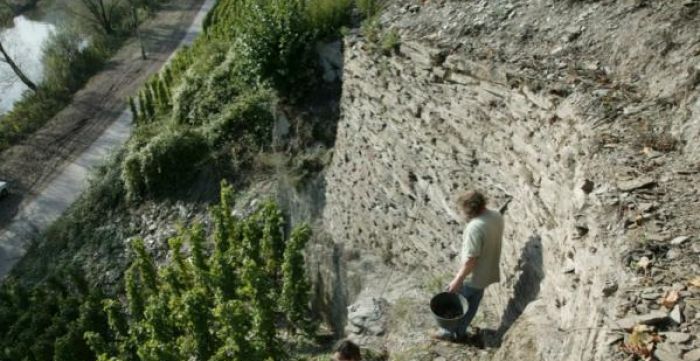
harvest report
14.08.2014
2014 Harvest Report from Rita Busch
<p><u><strong>November 24th, 2014:</strong></u></p>
<p>It is unusually quiet for this time of year at the winery. Normally we’re busy with the <glossary title="521">harvest</glossary> right through the middle of November. This year everything is different.</p>
<p><glossary title="1166">Bud break</glossary> began unusually early in 2014, and as a result of warm early summer temperatures, <glossary title="1179">flowering</glossary> was nearly complete by the end of May. This early development continued right into August. We expected an above-average number of <glossary title="1138">bunches</glossary>—it seemed nothing could go wrong. But it’s not for nothing that winemakers are careful with early predictions. Too much rain in September, combined with continued high temperatures, threw a wrench into winemakers’ plans this year. Grape skins were extremely thin, <glossary title="181">botrytis</glossary> and acid rot spread, and by the fourth week in September—practically overnight—we were forced to get going with the <span class="zalup"><span><glossary title="521">harvest</glossary><span>.</span></span></span> At first, only rotten grapes were picked out, but then everything had to move quite quickly due to the weather staying warm and humid.</p>
<p>For our team that meant four weeks of incredibly focused work. Every <glossary title="1138">bunch</glossary> had to be assessed and <span class="zalup"><span><glossary term="Sorting" title="1380">sorted</glossary><span>,</span></span></span> rotten grapes had to be kept out of our buckets (and therefore our wines!) at all costs. In certain <glossary title="760">parcels</glossary> well over half of the grapes were thrown away. Every winemaker’s heart breaks at such moments.<br />
<br />
In the meantime, we have managed to recover somewhat from the trials and tribulations of the <span class="zalup"><span><glossary title="521">harvest</glossary><span>.</span></span></span> Even if the <glossary title="1129">yields</glossary> are not particularly large, many <glossary title="142">barrels</glossary> were filled with juice. <glossary title="127">Auslese</glossary> levels were, on the whole, good-to-very-good, and flavor-wise we have a very good feeling. Despite everything we are quite pleased.</p>
<p>The <glossary title="">harvest</glossary> last year was also quite difficult and expectations about the wines were initially quite low. But once again <glossary title="858">Riesling</glossary> taught us a lesson, and the wines that emerged are elegant, full of finesse and have good <span class="zalup"><span><glossary title="71">acidity</glossary><span>.</span></span></span> They remind us a bit of the wines from 2008, which are showing beautifully at the moment. (Maybe you can still find a bottle in your <span class="zalup"><span><glossary title="254">cellar</glossary><span>!</span></span></span>?)</p>
<p><img src="http://louisdressner.com/uploads/images/article/2019_Sep_20//48/54/48540372b9d2e460210852012006f804.jpg" /></p>
<p><img src="http://louisdressner.com/uploads/images/article/2019_Sep_20//97/94/9794899bad8c42f258b33ef9f1cff058.jpg" /></p>
<p><img src="http://louisdressner.com/uploads/images/article/2019_Sep_20//d8/83/d88336a76423db9f94da918834ae5282.jpg" /></p>
Article

article
22.09.2020
Incredible photos of Clemens Busch's 2013 planting in Rothenpfad!
<p><img src="http://louisdressner.com/uploads/images/article/2020_Sep_22//ca/5d/ca5dad8b07756df2071bcf0d08acf271.jpg" /></p>
<p>Back in May, Clemens and Rita Busch started planting a parcel on the Rothenpfad part of the Marienburg. Holy moly is it steep!</p>
<p><img src="http://louisdressner.com/uploads/images/article/2020_Sep_22//b6/dc/b6dc5ed75b1db38657650ed9374a8fc3.jpg" /></p>
<p><img src="http://louisdressner.com/uploads/images/article/2020_Sep_22//78/95/7895e0ebd6af108618604aa98d642854.jpg" /></p>
<p><img src="http://louisdressner.com/uploads/images/article/2020_Sep_22//6a/70/6a7082f64457868ea120b531259c661a.jpg" /><img src="http://louisdressner.com/uploads/images/article/2020_Sep_22//71/6d/716d813008a9f91772cdd892c68abbbc.jpg" /></p>
<p><img src="http://louisdressner.com/uploads/images/article/2020_Sep_22//5e/fe/5efec120b48a6cbdb26fb89f9cd42206.jpg" /></p>
<p><img src="http://louisdressner.com/uploads/images/article/2020_Sep_22//09/1b/091bcf1f40abf74dab1556cc90a676ed.jpg" /></p>
Article



























